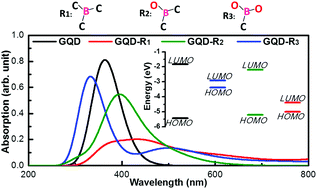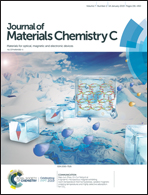Tuning the electronic and optical properties of graphene quantum dots by selective boronization†
Abstract
The optical properties of graphene quantum dots (GQDs) can be modified through introducing heteroatoms, including doping heteroatoms and covalent bonding with specific groups. Hence, we use density functional theory (DFT) and time-dependent (TD) DFT to understand the effects of boron doping configurations (i.e., BC3, BC2O and BCO2) on the electronic and optical properties of GQDs. Absorption spectra and HOMO–LUMO gaps are quantitatively calculated to study the correlations between the optical properties and electronic structure with different boronization and oxidation patterns. It demonstrates that BC2O can induce a red shift of absorption spectra, while the absorption spectra of the surface doped GQD with BCO2 exhibits a blue shift. According to the excited state analysis, BC3 plays an important role in determining the electronic transition, while the effects of BC2O and BCO2 on tuning the electronic and optical properties of GQDs are dictated by their hybridization form of carbon. Meanwhile, it indicates that the coexistence of B atoms and oxidized B bonding configurations can help charge transfer in the absorption process.



 Please wait while we load your content...
Please wait while we load your content...